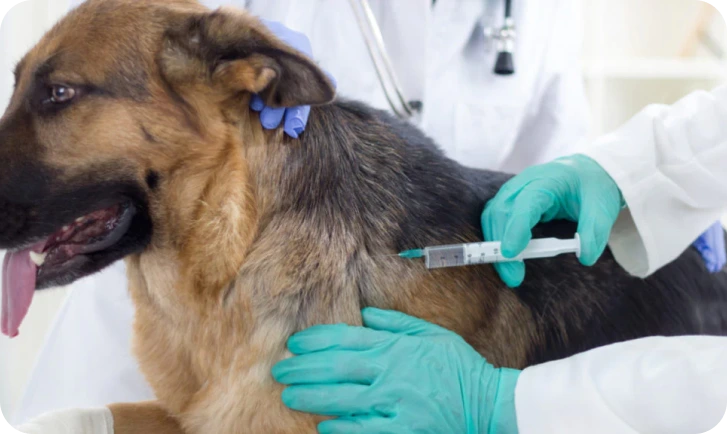-
 Vaccination and wellness services
Vaccination and wellness services
-
 General & Orthopedic Surgery & Dentistry
General & Orthopedic Surgery & Dentistry
-
 X-Rays & Ultrasounds
X-Rays & Ultrasounds
-
 General Pathology
General Pathology
-
 Flea & Worm
Flea & Worm
-
 Urgent Care
Urgent Care

Vaccinations are a vital part of the preventative health care of your pet and in minimising the occurrence of infectious disease in our pet population..

Canine Vaccination Protocol :
Puppies: 3 vaccinations given 4 weeks apart. Puppies have a temporary protection against many diseases, provided by antibodies from their mothers’ milk. These levels decline over their first few months, and until they have reduced they can render a vaccination ineffective, this is why a series of vaccinations is needed to ensure all puppies are well protected.
These are given at 6-8 weeks, 10-12 weeks and then 14-16 weeks of age.
Adults: Annual Booster
Feline Vaccination Protocol :
Kittens: 3 vaccinations given 4 weeks apart. As with Puppies, Kittens have a temporary immunity thanks to antibodies from their mothers milk which decline over the first few months, thus a series of vaccinations is needed. These are given at 6-8weeks, 10-12 weeks and then 14-16 weeks of age.
Adults: Annual Booster
It is advised that outdoor cats are also vaccinated against Feline Immunodeficiency virus (FIV).
Diseases we vaccinate against :

Canine Infectious diseases :
Parvovirus
Parvovirus is a highly contagious virus which infects rapidly dividing cells, in the canine population this most commonly results in severe gastrointestinal damage and clinical signs. Signs include; haemorrhagic diarrhoea, vomiting, loss of intestinal lining, lethargy, severe dehydration, abdominal pain. Left untreated this disease can lead to collapse, septicaemia and can be fatal. The disease is spread via ingestion of infected material (Faeces, soil) and can be carried on shoes and clothing. The virus is quite hardy and can last months within the environment.
Distemper Virus :
This virus infects both the respiratory and neurological systems. It is spread via contact with aerosol exposure or exposure to infected nasal secretions. This initial respiratory signs include; nasal discharge, sneezing, coughing, congestion, reduced appetite and can lead to pneumonia. Neurological infection can occur 1-3 weeks after the onset of disease. Clinical signs include; tremors, imbalance/wobbliness, weakness in the limbs.
Infectious hepatitis virus (Adenovirus) :
This disease is spread via exposure to infected secretions or via parasites. Once established within the dog’s bloodstream, this virus leads to severe liver damage, which depending on the patients immune status can lead to a sudden onset, fatal disease or lead to a chronic liver disease. Clinical signs include; depression, reduced appetite, vomiting, diarrhoea, abdominal pain and fever. Examination may reveal an increased heart rate, fluid within the abdomen, enlarged liver and signs of haemorrhage.
Canine cough (Bordetella bronchiseptica and Canine parainfluenza virus) :
Canine cough can be caused by a number of infectious agents, often in combination. The KC vaccination covers for both Bordetella (A bacteria) and the canine parainfluenza virus (A virus) two of the components of canine cough. Canine cough is an upper respiratory infection which in adult, vaccinated dogs causes a short lived uncomplicated disease, signs of which include; coughing, occasionally nasal and ocular discharge in a relatively happy dog. In younger or unvaccinated patients this disease can become complicated resulting in pneumonia, coughing, respiratory distress, reduced appetite and fever.
panleukopenia virus :
Related to the canine parvovirus this virus is highly infectious and very hardy within the environment. Almost all felines will be exposed to this virus at some point in time. This virus infects rapidly dividing cells including those within the lymph nodes, gastrointestinal system and bone marrow. This results in a range of clinical signs including; anorexia, dehydration, lethargy, vomiting, diarrhoea, painful abdomen, infertility and stillbirths (in pregnant animals). This disease cab be life threatening and requires prompt supportive treatment.
Calicivirus
This virus causes symptoms of the ‘cat flu’ disease to occur. Infection most commonly occurs via contact with an infected cat or from clothing which has contacted an infected animal. Clinical signs generally occur 2-6 days post infection and include sneezing, conjunctivitis, nasal discharge and, in some cases lethargy and a reduced appetite due to the development of oral ulcers..
Herpesvirus :
Another component of the ‘cat flu’ disease, this virus is shed in nasal, ocular and oral secretions and is spread via direct contact to an infected cat or to clothing which has contacted an infected animal. As with calicivirus signs generally occur 2-6 days post infection and include fever, lethargy, anorexia, sneezing, coughing, and nasal discharge.
Feline Immunodeficiency Virus (FIV) :
This virus is most commonly spread via bite wounds. This disease causes a reduction in the cats immune system, reducing the patients ability to respond to other infectious diseases. It is recommended that all cats with access to the outdoors be vaccinated against F.I.V. Patients with an unknown vaccination status or those which have not been previously tested are tested for F.I.V in clinic before the vaccination is given.
Microchips
Microchipping your pet provides a permanent way to identify your pet if they get lost. Microchips are implanted under the skin over their shoulder blades.
It is important to ensure that your details are kept up to date with the microchip registry if you move house or change phones to ensure your pet can be reunited swiftly..









